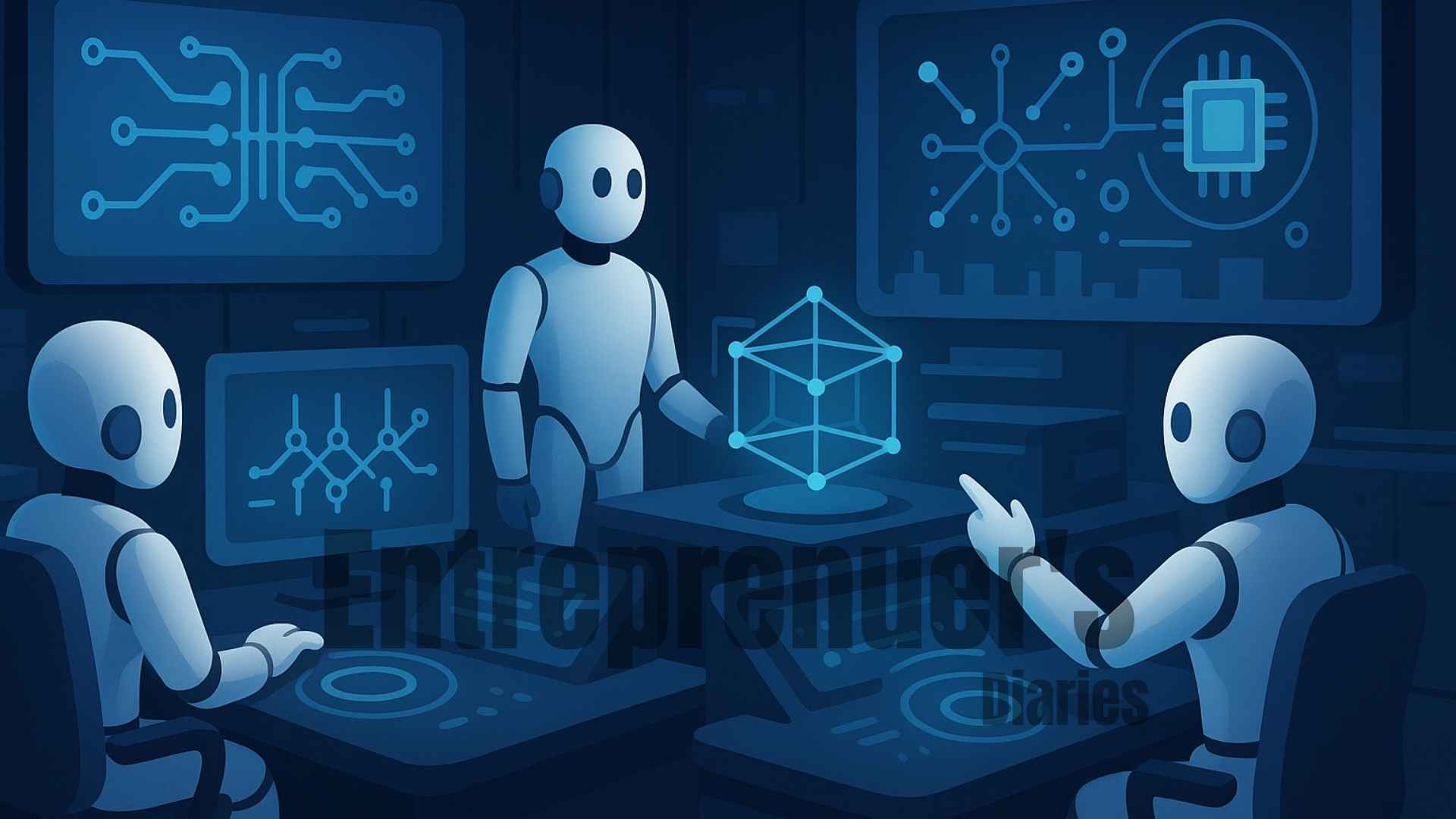Let’s skip the handwaving: 2025 isn’t shaping up to be “the year of AI” — it’s looking more like AI eats the entire software stack, drags quantum out of the lab, smashes reality into a spatial UI, and demands the grid be rebuilt in real-time. The industry calls it “strategic innovation.” The rest of us call it Tuesday.
- Agents That Work While You Sleep (Literally)
- AI Infrastructure: A War Over Silicon, Security, and Sanity
- Quantum’s No Longer a Science Project
- Spatial Computing: The Interface Nobody Asked For—Until It Worked
- 6G: Still Vaporware, But With Physics
- Green Nanotech: It’s Tiny, It’s Weird, and It Might Save the Grid
- Living Intelligence: Not a Sci-Fi Trope, an R&D Priority
- Edge Computing: The Real Hero of the AI Age
- Cybersecurity: Now Includes Reality Verification
- Advanced Nuclear: No Longer Taboo
Here’s what’s actually coming, stripped of the hype, tested against the hardware, and translated for people building the future — not pitching it.
Agents That Work While You Sleep (Literally)
If you still think AI means “chatbots and cute art,” you’re already behind. Agentic AI—autonomous systems that plan, execute, and learn across multi-step tasks—is what generative was to 2023. Only this time, it’s not responding to prompts; it’s running workflows, scheduling supply chains, doing QA on codebases.
Gartner ranks it #1 for a reason. This isn’t a smarter assistant. It’s a worker that doesn’t complain, doesn’t sleep, and doesn’t care about your Slack culture.
Companies are already building internal agents to automate procurement, customer onboarding, even regulatory reporting. Sounds great—until you realize your legacy APIs and compliance stack weren’t built for a robot middle manager. And regulators? Still treating this like it’s sci-fi. Time reports that Europe’s trying to catch up with the EU AI Act, but good luck regulating agents when they rewrite their own code mid-loop.
AI Infrastructure: A War Over Silicon, Security, and Sanity
Behind every AI agent is a massive energy bill and a data center on fire. According to Deloitte and Barron’s, budgets for AI hardware are jumping from 6% to 16% in three years. Why? Because building an agent that can understand your ERP system isn’t a lightweight process. It needs custom silicon, memory bandwidth, and thermal headroom.
The winners? Nvidia, obviously. But also Microsoft, which is spending like it’s the second coming of Azure. The edge case? Post-quantum cryptography. It sounds obscure—until you realize quantum machines might break today’s encryption by the time your agent hits version 3.0. Gartner isn’t exaggerating: this isn’t optional hardening, it’s a ticking clock.
Quantum’s No Longer a Science Project
Sure, quantum computing still sounds like a TED Talk. But for folks working in cryptography, finance, or optimization problems, it’s real—and uncomfortably close. Forbes flags it as a breakout tech, while Gartner puts post-quantum resilience in the top tier of enterprise threats.
The bottom line? Quantum isn’t killing classical compute. But it is forcing every CISO to re-architect their data protection strategy from the ground up. Quantum’s like a crowbar in the hands of a safecracker—and we’ve all been using the same safe since the 2000s.
Spatial Computing: The Interface Nobody Asked For—Until It Worked
Remember when Meta promised the metaverse and delivered overpriced headsets and legless avatars? Yeah. That was bad. But spatial computing is what survived—and it’s getting serious. XR is now powering digital twins, remote training, and spatial UIs that let you design factories in real time.
Think Figma for physical space, not Fortnite for meetings. Forbes says this shift will be as big as mobile was. That’s probably true—just don’t expect it to come from the usual suspects. Apple’s playing it safe. Meta’s throwing money at the problem. Startups in logistics and construction are where it’s actually sticking.
6G: Still Vaporware, But With Physics
Here’s the truth: 6G isn’t coming in 2025. But the terahertz research, intelligent metasurfaces, and AI-native radio protocols definitely are. According to arXiv, researchers are building wireless layers that adapt in real time to interference, demand, and signal loss.
Sounds academic—until you realize it’s exactly what’s needed to stream AR interfaces over dense urban networks. This is less “next-gen Wi-Fi” and more “invisible mesh layer for the AI operating system.” Don’t hold your breath for consumer rollout, but infrastructure people are watching closely.
Green Nanotech: It’s Tiny, It’s Weird, and It Might Save the Grid
The hottest tech in energy isn’t fusion—it’s structural battery composites and green nanotech. Think carbon fiber that stores power, water filters built from nanoscale membranes, and energy storage that fits in your shirt collar.
According to the WEF and even Wikipedia (yep, that’s how early we are), this stuff is moving fast. The hook? It’s not about saving polar bears. It’s about building lighter EVs, smarter batteries, and low-power chips that don’t need air-conditioned server farms.
Living Intelligence: Not a Sci-Fi Trope, an R&D Priority
“Living Intelligence” sounds like a Netflix show, but it’s legit. Harvard Business Review defines it as systems combining biotech, AI, and responsive sensors—basically, computers that act like living organisms. Not metaphorically—biologically.
Think neural organoids that train models, synthetic limbs that adapt on their own, and diagnostics that learn from their own feedback loops. It’s early, but real labs are working on this. If your tech feels “alive” in 2025, this is why.
Edge Computing: The Real Hero of the AI Age
IoT is old news. What matters now is where the processing happens—and for AI-heavy apps, that’s on the edge. With 30 billion devices projected by 2025, cloud latency isn’t cutting it. We’re talking real-time inference on smart cameras, drones, and factory robots.
What’s pushing this forward? 5G buildouts, energy-aware chips, and frankly, necessity. Nobody wants to wait 700ms for a cloud server to decide if your hand gesture means “open the door” or “start the machine.”
Cybersecurity: Now Includes Reality Verification
Forget firewalls. You now need tools to verify reality itself. Thanks to generative AI, we’ve hit the deepfake singularity. Gartner’s “disinformation security” isn’t a theory—it’s already a requirement in election infrastructure, media platforms, and even corporate communications.
AI-generated voice clones, video edits, synthetic documents—it’s all real, and it’s all cheap. That means your security stack now includes authenticity filters, chain-of-trust validators, and AI models that counter other AI models. Think digital judo.
Advanced Nuclear: No Longer Taboo
Yes, nuclear is back. But not your dad’s nuclear. Advanced modular reactors, osmotic power systems, and grid-integrated micro-nukes are now framed as clean energy solutions. The WEF lists them as top sustainability tech, and with AI data centers putting strain on the grid, even utilities are warming up to fission again.
The wild card? Public sentiment. The tech’s ready, the politics aren’t. But if blackouts hit and your AI agent goes offline mid-pitch, expect minds to change fast.
Bottom line: 2025 isn’t about waiting for disruption. It’s about building through it—sometimes with tools that don’t even exist yet. If you’re a founder, your stack should already include edge deployment, AI governance, and quantum contingency. If you’re an investor, follow the chips, not just the logos. If you’re a policymaker… try to keep up.
Connect With Us On Social Media [ Facebook | Instagram | Twitter | LinkedIn ] To Get Real-Time Updates On The Market. Entrepreneurs Diaries Is Now Available On Telegram. Join Our Telegram Channel To Get Instant Updates.
Ratnakar Upadhayay, known professionally as Ratnakar Mavilach, is an Indian businessman who is best known for coming up with the idea for Hinglishgram, the first content delivery platform in the world. His innovative endeavors range from launching Debonair Magazine back into the public sphere.






